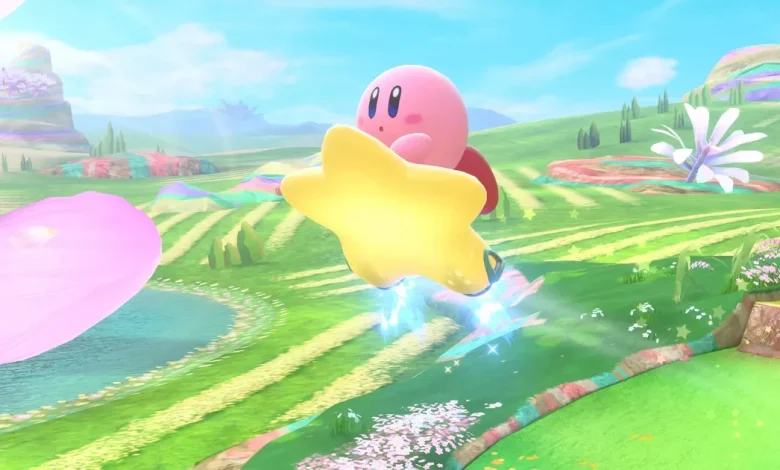Kirby Air Riders review – a refreshingly chaotic Nintendo kart racer that dares to be different

Nintendo Switch 2 gets an appropriately off-kilter kart racer that serves as the anti-Mario Kart, further leaning into its own hectic ideas.
11:46, 19 Nov 2025
Kirby is the only character that can deploy different special attacks mid-race depending on the colour you choose.(Image: Nintendo)
Kirby Air Riders is a chaotic sequel to the Nintendo GameCube classic that puts its foot and the gas and doesn’t really ever slow down.
More so than any Kid Icarus or Super Smash Bros. game, Kirby Air Riders has convinced me that this is Masahiro Sakurai’s world – and we Nintendo heads are just living in it. That’s because there are ideas present here I’m not sure any other game designer would include in a kart racer, let alone one starring a cutesy character typically reserved for younger players. In fact, calling Kirby Air Riders a kart racer at all doesn’t really do it justice. It’s just so unlike Mario Kart World or even this year’s utterly excellent Sonic Racing: CrossWorlds.
Is it your ultimate goal to race and finish first? I mean, I guess. At least some of the time. But how you go about doing so is always unpredictably chaotic. As such, it’s not a racing game for everyone. However, if you’re willing to meet Kirby Air Riders on its own terms and relinquish much of the control you’d typically expect to find in a racer, you’ll find a joyous and creative party game indicative of the Nintendo Switch 2’s best.
Much of this joy comes down to how generous a package Kirby Air Riders is overall. While it would have been easy to rip off Mario Kart World’s tournament system or new open-world setting, replace it with Kirby’s quirky cast, and call it a day in a bid to feel fresh, Air Riders picks up from the original and continues to follow the exact opposite tact.
This is a racer, not necessarily about improving your driving skills and getting better; it’s more about letting you indulge in short bursts of fun that just so happens to involve riding on a flying compact star or tank-like machine. Some of the most fun I had in my 30 or so hours playing didn’t even require racing to the finish, but rather gobbling up endless food or spin attacking large bosses within a certain time limit. Offbeat mini-games or racing twists like these are when Kirby Air Riders thrives, making for a unique flavour of chaotic karting.
Kirby Air Riders looks absolutely stunning on Nintendo Switch 2, achieving a mostly silky 60fps in handheld mode.(Image: Nintendo)
The main course of this seemingly endless buffet is, of course, Air Ride mode itself. Easily the most familiar to genre stalwarts, even this run of simple races is given an extra oddness due to how acceleration is an automatic process. Just like in the original Kirby Air Ride for GameCube, forward momentum is handled for you, with boosting around corners and hovering up enemies both tied to the B button. It’s a far more limiting control scheme compared to many of Kirby Air Riders’ peers, no doubt, yet it never fails to feel empowering due to how much importance the boost-based gameplay suddenly places on cornering.
Take a corner too wide without boosting, and your rivals are sure to bomb it right past you. Hold onto the boost button for too long while catching an all-important drift, meanwhile, and your vehicle will come to a complete stop. As far as racing mechanics go, it’s a decent level of complexity to squeeze out of one main button input, even if this does often result in the game feeling like it’s playing itself.
That said, throw in the ability to copy the abilities of enemies and use them as power-ups mid-race, alongside each character’s own special attack after building up a gauge, and there’s still plenty of actions and opportunities to stay on top of while racing through these gorgeous on-track locations.
Top Ride, by comparison, plays a lot more like a side dish, bringing over the same racing principles present in other modes and distilling them into a top-down racer. It puts me most in mind of the old Micro Machines games that took place on a tabletop, only here there’s no danger of falling off the edge, and the tracks themselves are full of several fun power-ups and shortcuts to exploit.
Racing in Top Ride isn’t as complex or even sophisticated as the main Air Ride mode, yet it serves as a nice shakeup to the main chaos and does well to break up the game’s typical racing style.
READ MORE: Razer Raiju V3 Pro review – an esports-level controller packed with killer featuresREAD MORE: Switch 2 getting underrated cosy game months after Xbox exclusive launch
To the air
Where almost all of these hectic elements come together is in both City Trial and the all-new Road Trip single-player mode. The former is just as ramshackle as it was before on GameCube, forcing groups of players to speed their way through a map in search of the best power-ups and upgrades for their machine. The player with the best powered vehicle will then receive an edge in the specific Stadium Contest mini-game that follows it.
City Trial is given an added sense of urgency thanks to the added graphical oomph on Nintendo Switch 2. Flying across the map at 60fps (or at least close to it) seriously ratchets up the stakes, letting you further lean into the chaos while trying to battle against others. It is a shame that City Trial, at least at present, only features one starting map to do battle on, though, since it makes racing around it quite repetitive.
As for Road Trip, it’s definitely one of the most ‘out there’ Nintendo narratives I’ve ever witnessed, which is pretty much what you’d expect from the same game developer who also gave us the Subspace Emissary in Super Smash Bros. Brawl back in the day.
Much like that mode, Road Trip aims to tell a single-player story that’s equally lavish and bonkers with what it sets out to achieve – as if we needed an explanation for the bond between, say, Knuckle Joe and his one-wheeled bike or any of the other riders and their machines. There’s certainly more to it than what it requires. That said, it’s perfectly in keeping with Kirby Air Riders’ specific brand of excess and acts as a great way for solo players to enjoy the same madcap randomisation seen in City Trial.
City Trial mode returns as the most chaotic and unpredictable mode, pitting acers against each other on a single map.(Image: Nintendo)
Speaking of randomisation, this is one area where Kirby Air Riders somewhat lets itself down a bit. Because while I’m all for relinquishing control in main races to further lean into chaos, it quickly becomes clear that not all Stadum contest mini-games found in City Trial and Road Trip are created equal. Sure, taking part in a simple drag race, trying to collect a string of power-ups or dodging a beam gauntlet against others is fine, but then a lot of the other challenges are either inconsistent or simply over too soon.
Gliding into a wall of numbers really isn’t all that exciting, I’m afraid to say. Even then, though, it’s not hard to steer votes towards those you do like when playing with a group of friends.
In many ways, Kirby Air Riders is very much the anti-Mario Kart World. Whereas Nintendo’s hallmark racer very much sticks to the established karting rules and tries to break new ground within it, Kirby’s first standalone Nintendo Switch 2 outing makes them up as it goes along – sometimes barely holding together as it tries to rein in the scope of its own ambition.
This is very much a sequel to that original 2003 game, only this time it’s not limited by the technology of the time. It means that, while Kirby Air Riders won’t be for everyone as a pure racing game, there’s still a lot of fun to be had here when boosting and competing in countless creative mode types. This is the kind of family-friendly kart racer only Nintendo – and more specifically, Sakurai – could make.
Rating: 4/5





